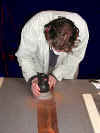|
It was around 1985 when we were
The Luthiers Mercantile and we had a container of Brazilian
rosewood boards to process into sets. It wasn't very good
wood, tended toward gray, was very wormy, lots of pinholes,
virtually nothing quartersawn, but it was Brazilian
rosewood. John Arnt from C.F. Martin came out to
inspect several hundred sets and took back with him
something over 100 sets. John said that at that time their
process was to bleach both the backs and sides, and then dye
them to match. He said they bathed both the backs and sides in
cyanoacyrlate to counter drying checks, and that they filled
the pin holes with sanding dust and epoxy.
|
That
wood was lighter colored, more like eastern walnut, and
disguising wormholes, checks, and the like was a fair amount
of work. Of course, they never went to extremes to disguise
the defects, but it is possible to completely hide most of
them if you need to. For example, some go as far as to use indelible black ink and continue a
grainline through and over a hole. And a few are known to
enhance a hole. Taku Sakashita, whose aesthetic is unusual, often fills a
wormhole with white, or a contrasting color rather than with a matching
color.
The below photos show a couple
of different ways of dealing with holes and are of builder
Stephen Stratton in action. The photos are thumbnails and can
be clicked on to enlarge. |

|
|

|
|

|
|
|
Anyone who's ever dealt with
Brazilian rosewood knows wormholes and pinholes, but have you
ever seen those pesky bugs? This is the end view of log which
was a standing dead tree. About 6" of the end was
lopped off to see the grain. |
|
This is
close-up of the bloated
lackey wood mongers: termites. |
|
|

|
|

|
|
|
Larger
than most wormholes, but not unusual in Brazilian rosewood,
this type of hole can be filled with cyanoacrylate or
two-part epoxy. Cyano is better for splits and checks because
of its wicking action, while epoxy is good where gap-filling
is needed
|
|
If the
hole is in the side, it's better to bend the side first. Cyano
can take about 350 degrees before it breaks down, while epoxy
will break down at about 150 degrees. Neither can withstand
bending temperatures.
|
|
|

|
|

|
|
|
Epoxy
might be a little faster to use than cyano, just because you
have to build up with layers of cyano (don't use the
gap-filling type).
|
|
The side
is bent, and ready to be repaired.
|
|
|

|
|

|
|
|
A
close-up of the worm hole.
|
|
Clean
out the hole.
|
|
|

|
|

|
|
|
Sanding
dust gathered and ready to be used.
|
|
Use
Scotch tape on the inside of side to back up the hole. Don't
use strapping tape or reinforced tape. It tends to lift up the
grain.
|
|
|

|
|

|
|
|
Mix
the 2-part epoxy.
|
|
Add
the sanding dust.
|
|
|

|
|

|
|
|
Pack
into the hole(s), and build it a little proud of the surface.
|
|
Let
dry.
|
|
|

|
|

|
|
|
Sand.
|
|
The
dust could have been a little darker, but it does darken up
when finish is applied, as in the photo below, left. (Note,
not all holes are filled in these photos.)
|
|
|

|
|

|
|
|
A
coat of finish is rubbed on to show how the filled hole blends
in. The filled hole will reflect light a little differently,
but if you use an epoxy with the same index of refraction as
the lacquer you are using, then you'll be fine.
|
|
A
close-up.
|
|
|

|
|

|
|
|
In
the above guitar by Ervin Somogyi, no attempt is made to hide
the wormholes. Wormholes are virtual assurance that the wood
is indeed, Brazilian rosewood.
|
|
A
beautiful quartersawn side has a resin pocket that will open
up in time. What to do? Fix it. Of course, this should have
been bent before fixing, but we were in a hurry. This example
will serve better if you pretend this side is a back.
|
|
|

|
|

|
|
|
These
are fairly common in the more figured wood. Often overlooked
as just heavy, hard, "black" lines, they should be
checked carefully for any sign of a fissure or cleft.
|
|
Gather
sanding dust and pack it in, using your finger, rasor blade,
and/or whatever else is needed.
|
|
|

|
|

|
|
|
Flood
the split with cyanoacylate (thin, not gap-filling).
|
|
When
dry, sand.
|
|
|
At
right, with finish on it, the fill is indistinguishable from
the surrounding wood. |
 |
|
|
|
|
|
|
|

|
|

|
|
|
The
larger wormholes should be plugged with a dowl.
|
|
This
wormhole is just to the right of the one in the photo at left.
We didn't fill it, but this is an example of a hole that is
very easy to disguise. Or this kind of hole can also be a
point of interest. In fact a glass eye might look pretty good
here.
|
|
|

|
|

|
|
|
Get
the next larger sized bit to drill through and clean the hole.
|
|
Make
a dowel out of matching wood using a knife and a sanding belt.
If you have a fastidious nature, you might want to make the dowel
so that edge grain (more stable, too) rather than end grain is
seen on the surface.
|
|
|

|
|

|
|
|
Cut
off a little dowel
|
|
Puddle
some glue into the hole. Titebond, or a high-test PVA glue can
be used.
|
|
|

|
|

|
|
|
Jam
the dowel in and let dry.
|
|
Chisel
off, sand and voilą, you're ready to finish.
|
|
|
Please
let us hear any comments, tips or tricks that we can add here.
We're happy to give you credit, or even better, a Brazilian
rosewood pen blank for making dowels. Wow! At
right is builder/repairman Stephen Stratton. It's his
handy-work we've covered here. |
|

|
|
|

|
|

|
|
|
Above
photo of Stephen taken when he worked at CFOX Guitars. |
|
In
order to conform to Allied Lutherie's dress code, Stephen was
forced to endure a complete makeover. |
|
|
|
|
|


New Price List


































